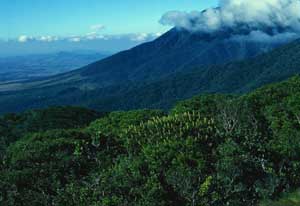|
|
 89 wet forest pastures DHJanzen100853.jpg high resolution
|
|
| This is a ground-level view from right to left (south to north) of the forest in the aerial image DHJanzen100852.jpg above. On the left is the edge of the dry forest and its pastures (light green). The burned area in the left side of image DHJanzen100852.jpg is the last yellow pasture clearly visible on the left above. Pastures cut into this upper elevation wet forest are invaded MUCH more slowly by forest than are those in the dry forest lowlands to the left. Why? First and foremost there are almost no wind-dispersed tree species in rainforest and cloud forest - this eliminates the massive wind-dispersed seed rain that is such a major part of the initial forest invasion of abandoned dry forest pastures and fields. Second, dry forest animals are not nearly as bothered by the strong sunlight, wind, dryness, UV and heat so characteristic of open pastures and fields (afterall, they have to put up with it during the six month dry season) as are many species of rainforest animals. The result is a much reduced animal-dispersed seed rain into rainforest pastures as compared with dry forest pastures. Third, when a seedling does become established in the severe conditions of a dry forest pasture, it is under conditions not much different from the dry season it is genetically and physiologically set up to handle. By contrast, the rainforest seedling surviving in an open pasture or field may well be in its equivalent of Death Valley, as contrasted with the rainforest understory or even a small tree fall clearing deep in the forest. Fourth, it may well be that mycorrhizal fungal spores are even yet scarcer in the deforested soils of rainforest pastures and fields as contrasted with those in dry forest - because in dry forest during the dry season, the fungi form spores that are blown all over the habitat, whereas rainforest fungi make fewer spores and make them less frequently. All of these factors in combination result in the phenomenon that in dry forest, a pasture can easily disappear into invading young forest in 10-20 years, while a rainforest pasture may look very similar to a pasture after 10-20 years of abandonment. This in turn causes the landscape manager to think seriously about planting trees in rainforest pastures, while it is good economics in dry forest to invest in stopping the assault by humans and let the forest invade on its own. | ||
back to lecture slides
or skip to: